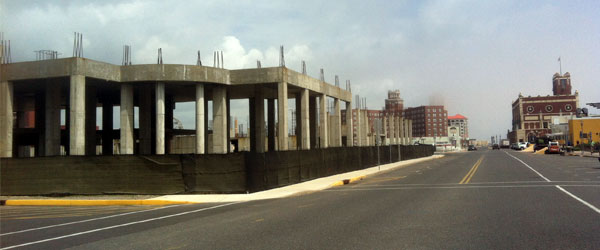iStar’s Block by Block Redevelopment Picks up Speed
Goals & objectives hint at Esperanza development and park initiatives
The underlying focus moving forward will be to keep Asbury Park’s spirit and to help create job opportunities and training programs for local businesses and residents, iStar Financial Senior Vice President of Land and Development, Brian Cheripka said during Saturday morning’s Homeowner’s Association meeting at Langosta Lounge.
An example of the latter is the Summer Ambassador Program that hires and trains local residents in the field of hospitality, he said.
But aside from the master waterfront redeveloper’s general objectives, there are the details – past and present.
Since 2011, when Cheripka [shown at right] took the helm of overseeing the city’s waterfront redevelopment, they have completed 18 separate property acquisitions, thereby acquiring 10 additional acres in the Waterfront Redevelopment Area [WRA]. This brings their total ownership up to 35 acres in the 56 acre redevelopment zone.
“What this does is really demonstrate our commitment to the community,” Cheripka said. “It also helps us plan better. As the market changes over time, it provides us with flexibility as we move forward.”
iStar has said it will not acquire any properties via eminent domain and has razed 25 of their vacant building, the most recent being on Second Avenue near Kingsley Street.
“I think it’s really important that as we try to change the way the waterfront looks and it feels…is to rid the vacant buildings and to replace it with landscaping or new construction,” Cheripka said.
According the city’s redevelopment plan for the area, it is envisioned to contain 3,164 residential units and close to 450,000 square feet of commercial space. The plan also calls for updating the utility infrastructure and improving public streetscapes.
Thus far we’ve seen iStar’s block-by-bock development of The Vive and the K. Hovnanian South Grand homes [shown at right], both with 28 units.
This past year construction of the Boutique Hotel at the former Salvation Army site that sat vacant since 2004 got underway and to help solve the city’s parking crisis, the redeveloper constructed three temporary parking lots and helped lay the foundation for the North Eats Food Truck Court.
But as construction of the 34-unit Monroe Condominiums project kicks off next month, all eyes will turn to the Esperanza.
The Esperanza was planned as a luxury condominium complex but construction stopped near the end of 2007 due to economic conditions.
“It’s time,” Cheripka said of plans to refurbish what many in the community call an eyesore.
He said only that more will be revealed in the upcoming weeks and months.
In the meantime the Monroe Condominiums [shown at right] are expected to be complete by next year. And while homes at the The Vive sold out within two days, there are still vacancies at the South Grand. Those homes went on the market in May but Cheripka maintains that their sales “are doing very well right now.
“On average these three for sale projects will bring in ten times the tax revenue than the vacant land,” Cheripka said to applause Saturday. “The great part about that is this tax revenue isn’t for the waterfront or the Central Business District, it’s really for the entire community.”
He said The Vive’s vacant land was paying $14,000 a year in property taxes but today it is generating $178,000 in net taxes to the city, meaning after the Payment In Lieu of Taxes [PILOTS] and different programs put in place to help finance infrastructure are calculated.
The city’s infrastructure financing program with the master redeveloper utilizes non-recourse bonds, Cheripka said. This means there is no impact on the city’s credit rating should the market turn. Because the master redeveloper is bearing the financial burden, the risk is being supported by them and future homeowners.
“We are the ones on the hook,” Cheripka said. “What happens if the projects don’t get built is that we don’t get paid. Throughout the entire program the city is getting their fair share on the for-sale housing.”
But at last week’s City Council vote on the tax abatement, council members Amy Quinn and Joe Woerner voted no. Although the agreement was approved by the majority, Quinn said she will vote no on any tax abatement agreement unless a stipulation is mapped out for local jobs and hiring, while Woerner objected in part to the burden being placed on future homeowners.
“I would like to see the master redeveloper take on more of a risk,” Woerner said.
Another controversial project in the pipe-line will be the rehabilitation of the Asbury Lanes [shown at right] building. The redeveloper plans on closing its doors at September’s end.
“We are just sorting out what we need to do to preserve the venue,” Cheripka said. “It will have bowling and music. The history will be preserved but the building needs a lot of help structurally.”
Also on the project list are commissioned murals by Pork Chop and signage – both the way-finding kind as well as those in their six private parking lots. Discussions to revamp the city’s waterfront area parks are expected to begin next month. Cheripka said while it is not a financially motivated investement, he hopes to help the parks become more ‘user friendly.’
BY THE NUMBERS
Since 2011 master waterfront redeveloper iStar Financial has invested:
More than $2 million in new landscaping, including the upcoming landscape improvements in front of Asbury Park Towers and its recent delivery of potted gardens for homebound senior residents
More than $8 million in local labor and vendor contracts
More than $10 million in new infrastructure, like streets repairs and lighting. They have replaced more than 150 street lights with LED lighting.
More than $2 million in project building permit and connection fees
And, more than $4 million in property taxes
——————————————
Follow the Asbury Park Sun on Facebook, Twitter and Instagram.














